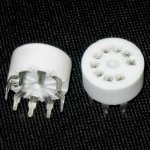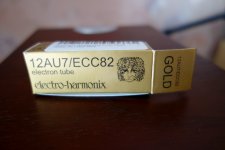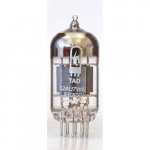V...
Did you mention an SMD version on the horizon ... perhaps incorporating the items you state above?
-TJ
I like SMD idea in general, however I have never tried to implement it. Maybe some day
could you put the link to the store?
Yes, sure - here is the link to particular product:
Good ceramic socket in Moscow
The site is in Russian.
Cheers,
Valery
Which pairs are "thermally coupled".
I see 5 coupled pairs on the PCB.
Hi Andrew, there are even 6 of them, however the last one not necessarily has to be coupled. Anyway, the pairs are (schematic from post #72):
Q1-Q2
Q6-Q10
Q7-Q8
Q11-Q16
Q13-Q14
Q9-Q12
I have left a bit of space around the tube for less thermal influence on the rest of the circuit, also the fact that the tube is located slightly higher than the other components ensures there is no problem with thermal stability.
Cheers,
Valery
I don't think Q1,2 Q7,8 and Q9,12 benefit from thermal coupling.
Well, CCS's thermal stability may slightly increase... but you are right - it was more a matter of "no problem putting them next to each other" on the PCB
The pass device has a small current and a very small voltage = very small power dissipation.
The controlling device has a very small current and a very large voltage = large power dissipation.
Heating the pass device with the controlling device does not help thermal stability, particularly drift during warm up.
The controlling device has a very small current and a very large voltage = large power dissipation.
Heating the pass device with the controlling device does not help thermal stability, particularly drift during warm up.
For the builders - example of a very good socket. Made of ceramic, designed for PCB mount, solid, great quality.
Purchased in a local online store. Less than $1 usd per piece. Got 6 pieces... for future builds
After buying the wrong ones first I ordered these. A little more money but supposedly "Gold plated". Coming from China so who knows when they will get here. I did get word that my PCB's have shipped so may see them in couple of weeks. Guess I need to buy some tubes. What brand did you say worked better for you?
After buying the wrong ones first I ordered these. A little more money but supposedly "Gold plated". Coming from China so who knows when they will get here. I did get word that my PCB's have shipped so may see them in couple of weeks. Guess I need to buy some tubes. What brand did you say worked better for you?
Terry, these sockets look very similar to the ones I've got here with the difference of gold-plating, which is always good to have.
Regarding the tubes. I've got 2 tubes from the Russian manufacturer "electro-harmonix". There are many different options - those ones just was easier to buy and I've read some good feedbacks on their performance.
Now - important point. For the best performance of the amp (and minimal DC offset), the tubes need to be selected for the best matching of the triodes inside them. My tubes were not selected, so, as I mentioned earlier, only one of them appeared properly matched. I have ordered another 4 tubes from the same supplier, just to have an opportunity to select myself.
Some suppliers offer the tubes already selected, with triodes matched, and some of them also offer the tubes in pairs with matched parameters. I recommend using this king of suppliers, just to avoid surprises and necessity of buying excessive tubes for selection. I have ordered 2 selected tubes from TAD manufacturer, just to test their performance and see if they are really properly matched.
In general, there is a big number of different brands and manufacturers of 12au7 - just better choose some known ones with "selected" offering for matched triodes.
Cheers,
Valery
Attachments
The pass device has a small current and a very small voltage = very small power dissipation.
The controlling device has a very small current and a very large voltage = large power dissipation.
Heating the pass device with the controlling device does not help thermal stability, particularly drift during warm up.
My view on this - the pass device actually provides a negative feedback on CCS output current. Right? As soon as output current, for instance, increases, voltage over the control device's emitter resistor increases = Vbe of the pass device increases, so the pass device drains bigger fraction of the controlling device's base current, tending the CSS output current to decrease. Thermal coupling of those two devices just adds thermal component to this negative feedback, making the output current less dependent on the outside temperature. Now simultaneous heating or cooling of both coupled devices lead to less CSS output current changes.
To fit these valve sockets to a PCB, what diameter holes need to be drilled?
Those are 0.07 inch holes, placed on the circle of 0.8 inch. Perfectly fits.
I would like what you say to be true, but I don't think that's the way it works.
But I could be wrong.
Any over Members want to offer a view on the CCS behaviour with regard to temperature effects?
I could be wrong as well, so qualified comments would be greatly appreciated.
I don't think that the temp of the pass transistor has much effect on total current, maybe only a small fraction. The sense transistor, however, when the temp increases, VBEon will decrease, which in turn reduces voltage drop across current set resistor lowering the current through the pass transistor. Assuming a 7mA CCS which uses a 100 ohm Iset resistor, can go from 7-6mA if the VBEon of the sense transistor is reduced by .1 volts. Rarely will a CCS of this low current will get hot enough for the VBEon to change unless the idle current of the sense transistor is unreasonably high. The problem becomes worse with increased current. A .7A CCS will reduce to .6A with the same .1 volt change. I say problem because a CCS changing its current is a problem. When using a CCS loaded SE type output stage it's recommended to mount the sense transistor away from the pass transistor.
Hi Valery,
You've probably realized I know nothing about how tubes work. So I don't know what is involved with the "pre-heater". Can you please explain what is required for that 6.3V power supply?
Thanks, Terry
Hi Terry,
Tubes require an independent power source for heating. It may be either AC (easier and cheaper), or DC (requires rectifier, electrolytic caps and a simple regulator, potentially providing less AC 60(50)Hz interference - more hi-end approach).
At the moment I simply use an additional small toroidal transformer with 6.3V AC output. Each 12au7 tube consumes 300mA (2 channels - 600mA), so I would recommend using at least 1A transformer, to be on a safe side - it is rather light and small anyway - for example, this one will perfectly fit the requirements:
AA50152-006-ND, TOROIDAL 15VA CHAS MOUNT TRANSFORMER
With this one, you can even use a separate secondary winding for each channel (it's got 2 of them).
I will test in a few days if adding DC regulator gives some tangible improvement - if yes, we will just add a simple regulator module, it will work with the same transformer.
As I mentioned earlier, it takes 10-12 seconds for the tube to heat-up, so it is safe to connect the speakers in about 15 seconds - by this time all the power-on transients will pass and zero-DC output get stabilized. So please make sure to tune-up the soft-start delay accordingly.
Cheers,
Valery
- Status
- This old topic is closed. If you want to reopen this topic, contact a moderator using the "Report Post" button.
- Home
- Amplifiers
- Solid State
- Low TIM, low distortion hybrid front-end


